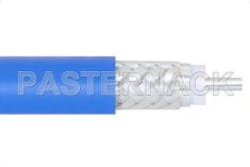Coaxial Cable Power Handling – Part 1
The coaxial cable provides a transmission line with low loss characteristics that can shield from outside signals and provide a durable yet flexible line that can be used in a variety of applications with a wide range of frequencies. Power handling capability, also known as the power capacity, is one of the important criteria in evaluating the performance of the RF coaxial cable. When considering medium or high power transmitter applications, power handling is especially critical, as the incorrect type of coax cable can result in a failure of the cable and possible damage to the transmitter.
Electrical losses in a coaxial cable creates heat in the center and outer conductors and, because most of the heat is generated at the center conductor of the cable, in the dielectric core. Power handling capability is related to the ability of the cable to withstand and dissipate this heat. In power handling, the maximum allowable operating temperature of the materials used in the cable, especially the dielectric, is the ultimate limiting factor. For applications with continuous power, heat loss within the cable is the limiting factor and, when using pulsed power through the coaxial line, operating voltage must not be exceeded. Thermal conduction of the coaxial line generally relates the physical properties of the cable with temperature. Specifically, thermal conductivity (k) is characterized through the quantity of heat (Q) transmitted in time through a thickness (L) in the direction normal to the surface area (A) due to changing temperature. Thus we have the rate of heat transfer in the cable and the thermal effects of the line, also known as power rating of the line.
As a rule, the power handling capability of a specific cable is inversely proportional to its attenuation and directly related to its size. Regarding coaxial cable power ratings, correction factors for ambient temperature, altitude and VSWR must be taken into account. For example, high ambient temperature and/or high altitude reduces the power rating of by impeding heat transfer from the cable and VSWR reduces power rating by causing localized hot spots in the cable. Which coaxial cable to use depends on the size and type of the line, the frequency of operation, the attenuation or loss, thermal conduction and capacitance. Each of these factors plays a key role in determining the power handling capacity of the line.
For a detailed look at the data used to develop recommended maximum power ratings for RF coaxial cable power handling, see Power Handling Capabilities of RF Coaxial Cables, 1971, http://www.dtic.mil/dtic/tr/fulltext/u2/912072.pdf. in which “representative coaxial cable types were subjected to high power CW and pulse tests” which were “conducted over a range of frequencies and ambient temperature and pressure attitudes.”
